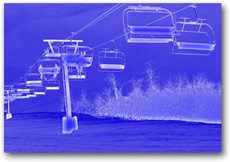 This is the time of the year when the thoughts of many skiers and boarders turn to their next-big-ski vacation. When planning ski trips outside the local area I am invariably drawn to ski resorts with large aerial lifts, such as gondolas, trams or cable cars. The bigger the lift, the better, is my mantra.
This is the time of the year when the thoughts of many skiers and boarders turn to their next-big-ski vacation. When planning ski trips outside the local area I am invariably drawn to ski resorts with large aerial lifts, such as gondolas, trams or cable cars. The bigger the lift, the better, is my mantra.
The kind of lifts that interest me the most are a mile or more in length and ascend at least two or three thousand vertical feet. I’m not alone in my fondness for these. Many larger US resorts feature such “signature” lifts in their brochures, websites, and publicity info. The main attraction with individual ski lifts that deliver a big vertical is the liberating opportunity to descend a significant chunk of mountainside in one fell swoop. Accompanying this is the feeling that you’re spending a lot more action-time on the slopes, rather than down-time in lines and lifts. The feeling is rare for most Mid-Atlantic skiers and boarders.
My personal concept of a major ski lift takes three forms: aerial trams, gondolas, and detachable high-speed chairlifts. How they are defined is a matter of interpretation. Some of the variations exceed my knowledge base. The largest and least common, trams and cable cars, are, in my view, essentially the same train-car like aerial conveyance. They typically hold 40 to 120 passengers, but with only two cars strung to an uphill wire or cable.
Gondolas are smaller, enclosed cabins built to contain approximately four to 12 passengers. Dozens of gondola cabins are attached to a single cable and the newer versions tend to have larger individual cabins, sometimes heated.
Detachable high-speed chairlifts are undeniably the third form of major ski lift in the US. They are less common in Europe, but we hyperactive Americans prize their efficiency. They sometimes cover verticals approaching those of trams and gondolas and have a much higher rate of uphill transport, but they don’t provide the same out-of-the-elements comfort factor as enclosed trams and gondolas. They can generate their own wind-chill factor.
Aerial trams generally deliver the maximum goods in the way of opening up lots of terrain with long runs and big vertical drops. Since only two cars usually run on a tram cable - one goes up, while the other goes down - this is not an efficient uphill transport method. They can get a might cozy when they’re packed like sardine cans for maximum capacity.
Trams, however, are the lift of choice over extremely steep, rugged, and/or expansive terrain. This is why there are so many of them in the precipitous and oversized geography of the Alps. Their wires can be strung on just a handful of huge towers separated by large distances. This often means occupants are treated to great views from ten or twenty times the distance off the ground of a typical chairlift. Their spectacular scenic value appeals to year round tourists.
The most scenic US aerial tram I’ve been on was at Snowbird, UT (125 passenger/3100’ approx vertical). This newly overhauled lift is frequently crowded during ski season. It rises high over some awesome, extreme terrain. The terminus places you on a small white knob at 11,000 feet on a summit they call Hidden Peak. There is no comfortable way down from here for low intermediates, but there is some eye-popping scenery and great snow for advanced and expert skiers/boarders.
While it’s not quite in the same category, a few years ago I found the new Cannon Mountain, NH tram (70 passenger/2100’ approx vertical) a great and somewhat exotic ride for the northeastern US. The first leg of the Cannon tram goes over a rather significant rock precipice. While approaching the precipice it was reassuring to glance hundreds of feet down at the New England Ski Museum near the base station. Positioned outside the museum was the antiquated, but fully intact car from the original 1930’s era Cannon tram. It looks like something from Captain Nemo and 20,000 Leagues Under the Sea, but it was tangible evidence of an enduring safety record!
The tram at Jay Peak, VT (60 passenger/2100’ vertical approx) was the one that got away from me. My one and only visit to Jay Peak, which is somewhat remotely located near the Canadian border, was on a typical February weekday in 1989. I was disappointed to find the tram down due to high winds. The wind was slight in my opinion. There was a very small crowd that day and I suspected a different factor might have been the real cause for the shutdown, a cost saving measure by management. Without the tram, the top 25% of the area is inaccessible. When it’s full-up, Jay is worth a day or two visit if you’re in the area. It’s one of the last tall peaks in the Green Mountains before things tend to flatten out in southern Quebec.
I believe there are only about ten aerial trams/cable cars in the US. I have no experience with a number of the most noteworthy examples, but can pass on the following second hand info. Heavenly Valley, CA has an old tram (50 passenger/2000’ approx vertical) affording magnificent views of Lake Tahoe. Nearby Squaw Valley, CA also has one (115 passenger/2000’ approx vertical), for possibly the closest tram tandem in the country. Jackson Hole, WY has the granddaddy of US aerial trams (60 passenger/4100’ approx vertical). It very likely holds the distinction of serving the most skiable terrain of any single lift in the US. A new and specially ruggedized tram has been opened at Big Sky, MT (15 passenger/4000’ approx vertical) in the last couple of years. The ride is supposed to be amazing. Much of the terrain it serves is treeless, extreme, and subject to severe winds and harsh weather.
The only European aerial tram/cable car I’ve been on is the one near Garmisch-Partenkirchen ascending the Zugspitz, Germany’s highest peak at 9,700’. This ride took place years ago and was far hairier than any aerial lift I’ve tried in the US. My guess is that it had a vertical rise of about 5000 feet. The beautiful Bavarian summertime view I enjoyed was much like what you’d get from a jet airliner.
While the car was docking at the summit terminal, the thought crossed my mind that if it ever broke loose from the cable it would drop about 500 feet straight down, hit the side of the cliff and not stop rolling until it came to rest in a beautiful blue lake a couple of miles below! On the return trip, just for variety, my wife and I rode back down on a cogwheel train through a tunnel inside the mountain. This covered the same huge vertical and, I suppose, offered a bad weather alternative for access to the upper slopes. A similar ski train got stuck and burned for days in a tunnel at Kaprun, Austria in the Fall of 2000, causing over 150 deaths in one of the greatest tragedies in skiing history. Nobody said we snow sports enthusiasts weren’t risk takers. Awesome aerial lifts and various other major modes of uphill transportation with incredible scenery are a dime a dozen in the Alpine region of Europe.
Husband, father and retired civilian employee of the Department of Navy, Jim Kenney is a D.C. area native and has been skiing recreationally since 1967. Jim's ski reporting garnered the 2009 West Virginia Division of Tourism's Stars of the Industry Award for Best Web/Internet/E-Magazine Article.

Join the conversation by logging in.
Don't have an account? Create one here.